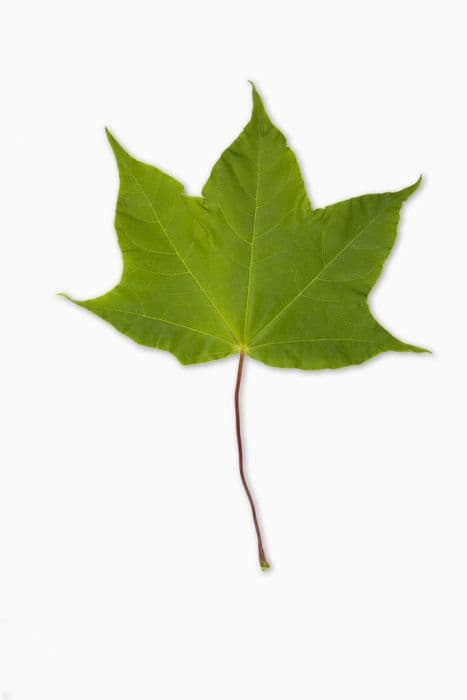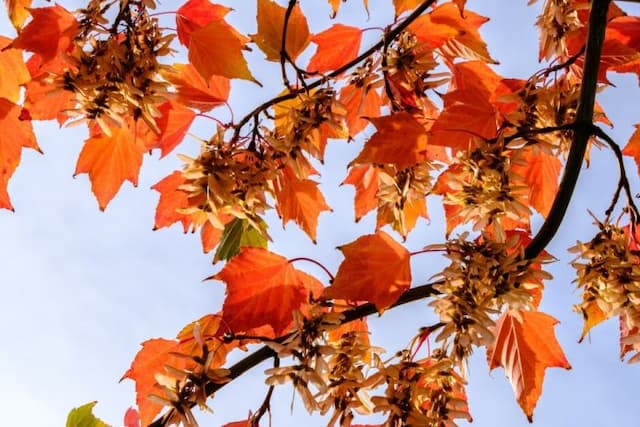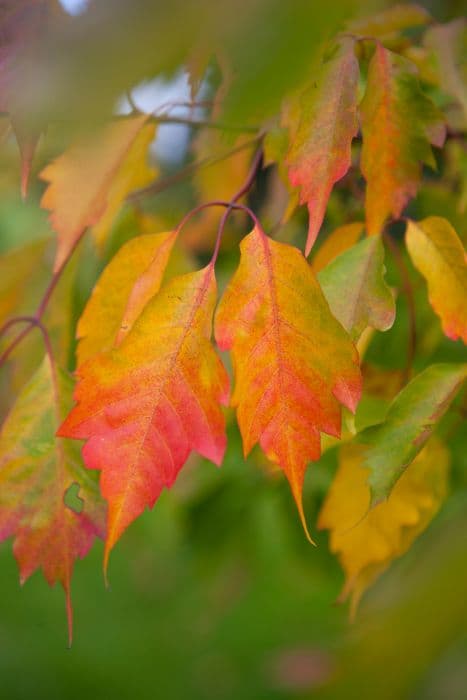Japanese Maple Acer palmatum 'Dissectum' (D)

ABOUT
The Japanese maple 'Dissectum' is known for its unique and delicate appearance. This ornamental plant boasts finely cut, lace-like leaves that create a soft, feathery look. These leaves typically have a deeply lobed and dissected form, which contributes to their intricate texture. The foliage emerges in a range of colors, often displaying a vibrant reddish-purple in spring that transitions to green during the summer. In the fall, the leaves dazzle with a spectacular array of bright oranges, reds, and yellows, providing a stunning display of color. The growth habit of the Japanese maple 'Dissectum' typically presents itself in a gracefully rounded, mound-like shape, which exudes an air of elegance and serenity. The branches spread outwards and often droop elegantly with the weight of the leaves, adding to the plant's overall beauty and visual interest. The bark is smooth with a grayish color that serves as a subtle backdrop to highlight the vivid foliage. This plant is appreciated for its artistic form and captivating hues, making it a favorite among garden enthusiasts for ornamental use in various landscapes.
About this plant
 Names
NamesFamily
Sapindaceae.
Synonyms
Japanese Maple, Cutleaf Japanese Maple, Threadleaf Japanese Maple, Laceleaf Japanese Maple, Dissectum Japanese Maple.
Common names
Acer palmatum var. dissectum, Acer palmatum 'Dissectum Atropurpureum', Acer palmatum 'Dissectum Viride'.
 Toxicity
ToxicityTo humans
The Japanese maple is generally not considered toxic to humans. There have been no significant reports of poisoning from consuming any parts of this plant, and it is not commonly known to cause adverse effects upon ingestion. However, as with any plant, individual allergies or sensitivities could result in mild irritation or discomfort if parts of the plant are ingested or handled.
To pets
Japanese maple is not commonly known to be toxic to pets either. There are no widespread reports of serious illness or symptoms in pets such as dogs and cats from ingesting this plant. As with any non-food plant material, ingestion can potentially cause mild stomach upset in some pets. If a pet ingests a large amount of the plant, it would be prudent to monitor for any signs of gastrointestinal discomfort and consult a veterinarian if any concerns arise.
 Characteristics
CharacteristicsLife cycle
Perennials
Foliage type
Deciduous
Color of leaves
Varies
Height
4-6 feet [1.2-1.8 meters]
Spread
4-8 feet [1.2-2.4 meters]
Plant type
Tree
Hardiness zones
5-9
Native area
Japan
Benefits
 General Benefits
General Benefits- Ornamental Value: Acer palmatum 'Dissectum', commonly known as Japanese maple, is prized for its beautiful lace-like foliage that provides a unique texture and shape in landscapes.
- Seasonal Interest: It offers vibrant seasonal colors, with leaves that change from green in spring and summer to stunning shades of yellow, orange, or red in autumn.
- Shade Provider: The canopy of the Japanese maple can offer a cool, shaded area during the hotter months, making it ideal for planting in residential gardens.
- Size Suitability: It's a compact tree, which makes it suitable for smaller gardens or spaces where a full-sized tree would be impractical.
- Wildlife Support: The tree can provide habitat and food for birds and other wildlife, enhancing biodiversity in the garden.
- Versatility in Landscaping: Japanese maples can be used in a variety of landscape settings, including as a focal point, in containers, or as part of a mixed border.
- Low Maintenance: Once established, they require minimal care aside from occasional pruning to maintain their shape and promote good health.
 Medical Properties
Medical PropertiesThis plant is not used for medical purposes.
 Air-purifying Qualities
Air-purifying QualitiesThis plant is not specifically known for air purifying qualities.
 Other Uses
Other Uses- Japanese maple bonsai - 'Dissectum' can be trained into a bonsai form, offering a miniature landscape aesthetic for enthusiasts of the bonsai art form.
- Educational tool - The distinct leaf shape and growth pattern of the Japanese maple can be used to teach about plant morphology and botany studies.
- Photography subject - With its unique foliage, the Japanese maple serves as an excellent subject for nature photographers, especially in autumn.
- Contrast in floral arrangements - The finely dissected foliage can be used in floral designs to contrast with larger, bolder leaves or flowers.
- Artistic inspiration - This cultivar's striking appearance throughout the seasons inspires artists in various mediums such as painting or sculpture.
- Film and theatre sets - The tree can be used in set design, providing an atmospheric backdrop with its elegant structure and changing colors.
- Feng shui - In the practice of feng shui, the Japanese maple's graceful form and colors can be used to enhance the energy of a garden space.
- Shadow play - On sunny days, the intricate leaves of 'Dissectum' cast delicate shadows that can be used creatively in landscape design or photography.
- Seasonal celebrations - In Japan, viewing the changing leaves of maples is a popular autumn activity, and 'Dissectum' with its vibrant colors is an excellent choice for such events.
- Leaf castings - Crafters use the distinct leaves of the Japanese maple for making leaf-shaped castings and imprints for decorative art pieces.
Interesting Facts
 Feng Shui
Feng ShuiThe Japanese Maple is not used in Feng Shui practice.
 Zodiac Sign Compitability
Zodiac Sign CompitabilityThe Japanese Maple is not used in astrology practice.
 Plant Symbolism
Plant Symbolism- Beauty in Diversity: The Japanese Maple, particularly the 'Dissectum' cultivar with its finely cut leaves, represents the beauty that can be found in diversity and the unique. Each leaf is intricately shaped, symbolizing how differences make something beautiful.
- Change and Transition: Known for their stunning seasonal color changes, Japanese Maples embody the essence of transition and change, reflecting the nature of life's constant flux.
- Peace and Serenity: With its delicate foliage and graceful growth habit, the Japanese Maple is often associated with creating a tranquil and peaceful environment, inviting quiet contemplation.
- Endurance and Patience: Although delicate in appearance, the Japanese Maple is hardy and resilient. It symbolizes the virtues of endurance and patience through the challenges and adversities of life.
- Balanced Strength: The plant's ability to withstand harsh conditions while maintaining its elegance makes it a symbol of balanced strength - embodying both resilience and gentleness.
 Water
WaterThe Laceleaf Japanese Maple should be watered deeply once a week during the growing season if there's no significant rainfall, ensuring that the soil remains moist but not waterlogged. In periods of drought, an additional watering may be necessary. Use 1 to 1.5 gallons of water for young trees each time you water. Reduce watering in the fall before the tree goes dormant, and during winter, only water if the soil is very dry. Adjust watering frequency based on weather conditions but avoid letting the soil dry out completely.
 Light
LightLaceleaf Japanese Maples thrive in a location with filtered sunlight or partial shade, particularly in the hotter parts of the day. They can tolerate full sun in cooler climates but prefer protection from strong afternoon sun to prevent leaf scorch. Ideal placement is where the tree receives morning sunlight and afternoon shade, or dappled light under the canopy of larger trees.
 Temperature
TemperatureLaceleaf Japanese Maples can survive in temperatures as low as -20°F and as high as 90°F, but they prefer a range between 60°F and 80°F. They are hardy and can withstand winter cold, but young trees may need protection from frost. During heatwaves or unusually hot weather, extra care may be needed to ensure the plant does not suffer from heat stress.
 Pruning
PruningPrune Laceleaf Japanese Maples in late winter or early spring to remove dead or damaged branches and to shape the tree. Thinning the canopy every few years allows light and air to penetrate, promoting good health. It's not necessary to prune yearly, but occasional pruning will maintain an attractive form and manageable size.
 Cleaning
CleaningAs needed
 Soil
SoilJapanese Maple thrives in well-draining, acidic to neutral soil with a pH between 5.5 and 7.0. A mix containing 1/3 peat, 1/3 bark fine, and 1/3 pumice or perlite is ideal to provide the aeration and moisture retention needed for healthy growth.
 Repotting
RepottingJapanese Maples should be repotted every two to three years during the dormant season to refresh the soil and encourage health, typically when they are young. Older, more established trees may be repotted less frequently, every four to five years.
 Humidity & Misting
Humidity & MistingJapanese Maples prefer moderate humidity levels. While outdoor plants generally adapt to local conditions, indoor plants benefit from a humidity level between 40% to 60%. Too dry air can cause leaf crisping.
 Suitable locations
Suitable locationsIndoor
Place in bright indirect light, protect from drafts, ensure moist soil.
Outdoor
Grow in partial shade, shelter from strong winds, mulch well.
Hardiness zone
5-9 USDA
 Life cycle
Life cycleAcer palmatum 'Dissectum', commonly known as Japanese maple, starts its life as a seed, which after stratification, germinates in spring. The seedling stage follows, characterized by the growth of the first true set of beautifully dissected, lace-like leaves. As it enters the juvenile stage, the sapling develops a stronger root system and branching structure, gradually adopting its distinctive mounded shape. In maturity, the Japanese maple exhibits a fully developed form with dense foliage and may produce small purple flowers, followed by winged samaras, or 'helicopter' seeds, typically maturing in late summer to fall. An established mature tree goes through yearly cycles of growth in the spring and summer, followed by a period of dormancy in the winter. The lifespan of a Japanese maple 'Dissectum' can exceed 100 years, with each year marked by a stunning display of fall colors before leaf drop and entry into the winter dormancy phase.
 Propogation
PropogationPropogation time
Late spring to early summer
The Japanese Maple 'Dissectum', a prized ornamental for its finely cut, delicate leaves and graceful growth habit, is commonly propagated through grafting. Grafting is favored as it faithfully reproduces the parent plant's characteristics, especially important for cultivars with specific traits like 'Dissectum'. This technique involves joining a piece of the desired cultivar, known as a scion, to a rootstock that offers vigor and hardiness. The ideal time for grafting is late winter or early spring, before the sap starts flowing and the plants break dormancy. The scion is carefully spliced onto the rootstock, ensuring the cambium layers—that is, the growth layers—of both are closely aligned. The graft union is then bound and sealed to protect it from drying out and to promote successful healing and integration of the scion and rootstock, which typically takes several weeks.









